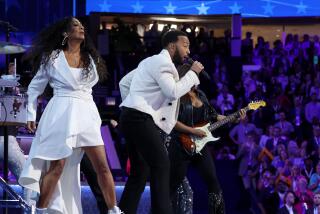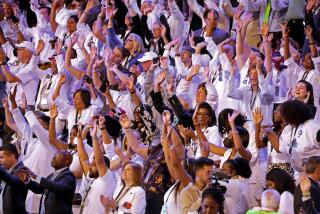Candidate Chic: Dressing for Presidential Success
Here’s a campaign issue that has come out of the closet: Do clothes make the presidential candidate?
“Clothes say honest or dishonest, trust him or don’t trust him,” insists John T. Molloy, hater of bow ties, lover of white shirts, author of the original bible of corporate camouflage, “Dress for Success,” and a new, improved version published earlier this year.
Then a politician can truly be judged by his coverings?
“Ridiculous,” sniffed Dorothy Sarnoff, a former consultant to candidate and Sen. Bob Dole (R-Kan.) and one-time presidential possible Rep. Patricia Schroeder (D-Colo).
Presence Is Important
“What is underneath the clothes is much more important and I’m not talking of anything but that important word presence . . . how you carry yourself, your bearing, how you write your speech, all the behaviors.”
Molloy, dress consultant to corporations and governors, believes that before his Rice crisping, candidate Gary Hart was presenting a “wonderful image.” On the other hand, Sarnoff, who says her seminars have introduced 70,000 persons in 14 nations to the essence of presence, begs for no comparison between “the droop that Hart had with the class bearing of (Sen.) Albert Gore (D-Tenn.) and (Delaware Gov. Pierre) du Pont.”
In the wardrobe stakes, Molloy agrees, Gore “probably is doing it rather well.”
Sarnoff also likes former client Dole for selecting attractive ties and pastel shirts. Molloy, however, thinks Dole should trash his beige and brown suits “for high authority blues.”
And so go the sartorial polls as the presidential field shortens, and image brokers take an unpaid interest in the cut of candidates’ jibs.
Molloy claims that his 15 years of research, books, lectures and corporate counseling were first to “equate clothing with power and money, a corporate tool.”
“Clothes send a socioeconomic message, from the Arapaho to today’s Americans in pin-striped suits,” he says. “British Prime Minister Margaret Thatcher dresses to say: ‘I am a power figure. I am in charge.’ Ronald Reagan does it very well because he was brought up in an image industry.”
Molloy--in San Francisco recently on a book-plugging tour--is concerned that few candidates of either party are dressing for total presidential success. They’ve learned that conservative blue suits imply authority, white shirts indicate morality, and dark red ties belong to everyone’s favorite relative.
“But they are not as sophisticated in all areas of public image as is (Soviet leader Mikhail) Gorbachev who, frankly, is going to be their competition,” Molloy said. “We have to elect someone who can go to Europe, meet Gorbachev head-on and come out on top in a close bout.
“The survival of this nation and the West may depend on the ability of our president to manipulate. And dress, body language, a whole series of things is part of that. And, frankly, they (candidates) are not good at it.”
Sarnoff, president of Speech Dynamics of New York, again disagrees. She believes that Molloy’s way is the selection of Presidents by cookie cutter. Clothes, she said in a telephone interview, should be an honest expression of self. Not flimflam.
Ergo, any man who was absolutely right for the job could likely win the White House after campaigning in a pillowcase.
“If you make that declaration of: ‘I know who I am and I know that I know’ you can wear almost anything, truthfully,” Sarnoff said.
Yet on one dress item and one candidate, Molloy and Sarnoff are in absolute accord. They don’t like Sen. Paul Simon’s (D-Ill.) bow ties.
Not for Candidates
Bow ties, snorted Molloy, are OK on clowns, college professors and Pee-wee Herman. But not on presidential candidates.
“Simon’s bow tie was an announcement to the electorate that: ‘I’m outside of the norm and you don’t know what I’m going to do,’ ” he added. “People don’t want a man that independent with his finger on the trigger.”
For both experts, others in the current lineup look something like this.
Rating the Pack
Massachusetts Gov. Michael Dukakis:
“Too Boston, too Hahvaard in his clothing,” Molloy said. “He is dressing for his Northeastern, liberal Establishment constituency but it doesn’t travel. And he should have his eyebrows trimmed back.”
Wrong, Sarnoff said. If Dukakis favors button-down shirts and tweed sport coats, so be him. “Shaggy eyebrows, shaggy hair, shaggy jackets,” she said. “Quite appropriate.”
Vice President George Bush:
“His clothes, surprisingly, do not fit him well,” Molloy said. “He looks like someone who is washed out and unsure of himself. He looks dull.”
‘His Clothes Hang’
Sarnoff doesn’t fight that. “He’s very thin and maybe that’s why his clothes hang on him a little more,” she said. “Male frumpishness.”
Evangelist Pat Robertson:
Safe and conservative and two-piece and inoffensive and well accustomed to the correct clothes for television appeals, Molloy said.
“I go by distractions, and with Robertson there has never been anything that distracted me,” Sarnoff added.
Rep. Dick Gephardt (D-Mo.):
“Very well-dressed,” is Sarnoff’s vote.
“Solid suit, white shirt, striped tie,” went Molly’s aye. “He’s got it down.”
The Rev. Jesse Jackson:
Sarnoff likes him. She thinks Jackson has fashionability. Although, she says, he might have a tendency to overdress.
Molloy has some free advice for Jackson: “He is too sharp, too chic, too well put together, too beautiful,” he said. “Jesse Jackson is dressing in clothes that are telling black America that he is one of them. He should be dressing to tell white America that he is one of them.”
Yet Molloy does see a way out for Jackson.
“If only he and George Bush could switch closets,” he suggested.
More to Read
Get the L.A. Times Politics newsletter
Deeply reported insights into legislation, politics and policy from Sacramento, Washington and beyond. In your inbox three times per week.
You may occasionally receive promotional content from the Los Angeles Times.










